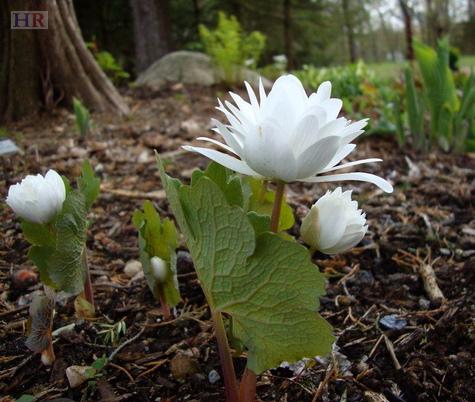Ephemeral Beauty of Bloodroot
Spring is the season we all await impatiently. During this time of year, I can be found scouting my gardens nearly every day, searching for the slightest hint of new green growth pushing up through the bare earth. Already, there are crocuses and snowdrops in bloom in my gardens and in just a few short weeks, the early spring ephemerals will be in full force with their delicate and fleeting beauty. Bloodroot is one of the first of these early bloomers and it is also one of the loveliest. Pure white, upward-facing flowers and thick, grayish-green leaves grace this beautiful, yet rugged, woodland perennial.

Bloodroot (Sanguinaria canadensis) derives its name from the dark red sap contained in its foliage and rhizomes. This sap makes Bloodroot unpalatable to deer. It is native to eastern North America, from Canada south to Texas and Florida, and is hardy to Zone 3. In its natural habitat, it thrives in deciduous woodlands, where spring sunshine is followed by dappled summer shade. Although it prefers rich, moist soil high in organic matter, it can adapt to a wide range of soil and moisture conditions, making it ideal for shady spots in the suburban garden. It does not tolerate soggy or extremely dry conditions. It spreads by fleshy, orange rhizomes that lie one to three inches below the soil surface. It also spreads by seed and can form extensive swaths in the woodland.
Bloodroot is one of the many woodland wildflowers whose seeds are spread by ants, a process called myremecochory. Ants gather the seeds and store them in underground nests where they feed upon a fleshy appendage attached to each seed. In this way, the ants essentially plant the seeds in an environment where they stay protected until they germinate the following spring.
When Bloodroot first emerges from the ground, each flower bud is wrapped tightly by a single leaf. As the leaf unfurls, it folds in half and gently clasps the flower stem. The flower stem pushes upward past the leaves, and the bud opens to reveal snow-white petals on flowers that are two inches wide. Individual flowers drop their petals within a few days of fertilization, but the leaves continue to expand to five to eight inches, creating a unique, bold-textured ground cover of deeply lobed foliage that lasts well into autumn. Bloodroot is easy to grow by planting divisions of its fleshy rhizomes in spring. It will also spread in the home garden by self-seeding.
Two noteworthy forms of our native Bloodroot are the single-flowered pink form and the double-flowered white form (S. 'Multiplex'). The flowers of S. 'Multiplex' resemble miniature water lilies that seem to float above the foliage. The flowers are sterile, longer-lasting and stunning. The pink form has deep pink buds that open to light pink flowers. Plus, the stems of the leaves and flowers are a rich, dark pink. Both forms prefer shaded, woodland conditions and both perform well in the home garden.
In my gardens, a sizable patch of Bloodroot grows between a large-leaf rhododendron and a variegated dogwood (Cornus kousa 'Wolf's Eye'). I can see the single white flowers of the Bloodroot from my living room window. I know they won't last long, so I make sure I get out there on a sunny day to enjoy their simple elegance. In summer, the large, lobed foliage plays nicely with hosta, pulmonaria and astilbe. The double-flowered form of Bloodroot grows beneath a large cedar, where its exquisite flowers take my breath away. Its summer foliage is particularly large and holds its own with a large clump of 'Brilliance' Autumn Fern (Dryopteris erythrosora 'Brilliance') and large-leaved hosta (H. 'Deep Blue Sea' and H. 'Three Sisters'). I am still on the look-out for my next acquisition: the pink-flowered form. I know I can make room for it, somewhere.
Bloodroot can be purchased from online sources such as Arrowhead Alpines, www.arrowhead-alpines.com. It is also available locally at Garden in the Woods, the headquarters of the New England Wildflower Society, in Framingham. Garden in the Woods opens this year on April 15, a date that coincides with the time that many spring ephemerals, including Bloodroot, have emerged from winter dormancy and carpet the woodlands with their elegant beauty.
(Joan Butler is co-owner of Enchanted Gardens, a garden and design landscape firm in Holliston, www.enchantedgardensma.webs.com, and a past president of the Holliston Garden Club.)